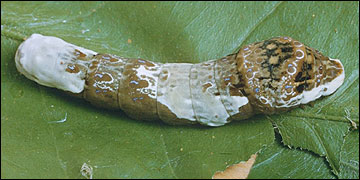Orangedog
Swallowtails
 Orangedog caterpillars (Papilio cresphontes) are present from July to October. They produce two generations per year. They are considered a pest to citrus trees.
Orangedog caterpillars (Papilio cresphontes) are present from July to October. They produce two generations per year. They are considered a pest to citrus trees.
Orangedog caterpillars look like bird droppings throughout their development. Full-grown larvae are dark brown and white. The head has a white lateral collar that extends to the sides of the thorax. The third thoracic and first abdominal segments are swollen and arched with brown and black marbling. The third and fourth abdominal segments have a white saddle-like area that extends laterally. The last three abdominal segments are almost entirely white. Dorsally, from the thorax to the tip of the abdomen there are small, irregularly shaped blue spots. Primary host plants in the Midwest are the hoptree and pricklyash. The name "orangedog" comes from the fact that the caterpillar is a pest of citrus trees in the southern states. The adult is called the giant swallowtail butterfly.
About the family
Swallowtail caterpillars of the Papilionidae family are usually smooth-bodied and vary in color from green or yellow-orange with black markings to a color pattern that gives them the appearance of a bird dropping or the head of a vertebrate with conspicuous "eyes." All swallowtail caterpillar species possess a scent gland called an osmeterium that is located just behind the head. When disturbed, this fleshy-looking, forked, orange-red gland is everted from its pouch and releases a disagreeable odor. Because the caterpillars are relatively large and very colorful, they too (with royal and silkworm caterpillars) are quite noticeable. Very few species would be considered important pests. Many adults from this family are colorful and beautiful medium-size to large butterflies. Their name is derived from the presence of tail-like projections on the hind wings.